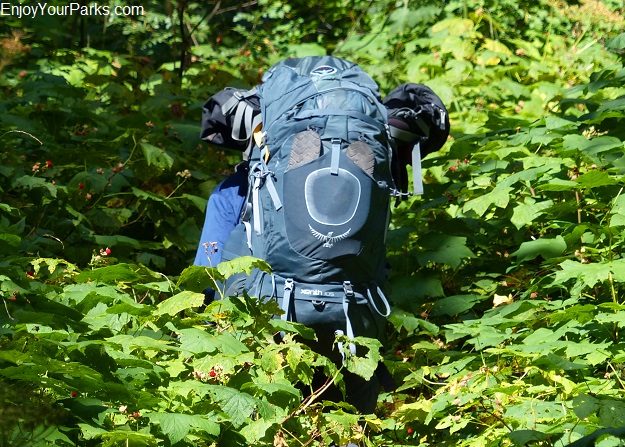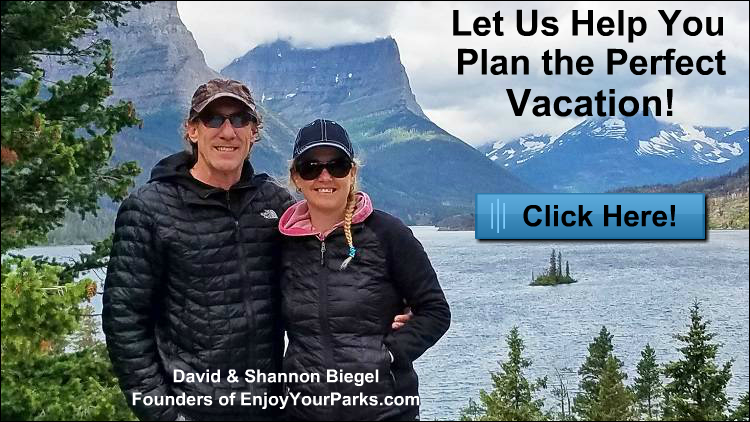Glacier Park Overnight Backpacking Tip:
Ten Important Items

Glacier National Park backpacking on the Gunsight Pass Trail.
Glacier Park Backpacking Tips:
10 Important Items
That Can Make Or Break
Your Glacier Park Hiking Experience
10 Important Items To Bring On Your Glacier Park Backpacking Adventure

Sue Lake Overlook near Fifty Mountain in Glacier Park.
Through our lifetime of hiking and exploring the backcountry of Glacier Park and many other areas of the Northern Rockies, we've learned a thing or two about what to bring on a multi-day backpacking adventure. Aside from the basics, the following 8 items are things that we feel will help make your Glacier Park backpacking adventure a wonderfully positive experience, but are things that are commonly forgotten. Again, this short list is based on years of our very own personal experiences, and we want share this short list with you because it will really help enhance the enjoyment your Glacier Park backcountry experience.
1) Mosquito Spray
Glacier Park is not typically a “buggy” place in the summer. However, there are certain areas (such as Brown Pass Campground) where the mosquitoes can be quite bad. So one thing that you cannot forget is bug spray. Seriously.... as it could make or break your experience. If you don't have bug spray at Brown Pass Campground (for example), the mosquitoes are so bad there that you will be picked up and carried away by a giant swarm of mosquitoes, never to be seen again.
2) 25 Foot Rope
All food and cooking gear at your campground must be hung at least 10 feet off the ground when not in use, and you will need a 25 foot rope to make this happen. There are some super-strong, thin and light weight ropes on the market, very similar to a parachute chord, that are ideal for hanging your food. Also, there are the occasions that you may need to hang your pack as well. For example, you may want to run up to Sue Lake Overlook at Fifty Mountain without your overnight pack on your back, so you will need to hang your pack at the campground. So make sure your rope is strong enough to support your pack.

3) Bear Spray
You are hiking in Glacier Park, which is classic grizzly country. Always carry bear spray and have it readily available. "Available" means have the bear spray either on your hip or on your chest. rather than in your backpack. Also, know exactly HOW and WHEN to use it. It’s unlikely you’ll ever need it, but if the time comes, your life may depend on how skilled you are with your spray. We'll talk about other things you need to be doing while hiking in grizzly country in a future article.
4) Sunscreen
We both have had melanomas on our skin due to sun exposure as well as basal cell carcinomas. For decades we neglected our skin during all of our outdoor adventures, and we are now paying for it. Melanomas are among the most deadly form of cancer if it is not detected early, and basal cell carcinomas can be devastatingly destructive, especially on the face.
Of course the best thing to do is to AVOID getting a melanoma or basal cell carcinoma in the first place. One of the fundamental steps to avoid skin cancer is to use sunscreen on exposed skin at all times. But it on about 20 minutes before your hike begins, and re-apply every few hours. Now of course there are other important things you can do to avoid skin cancer, like wearing a hat with a large 360 degree brim, and wearing protective gloves, and wearing only UV blocking long sleeved shirts and pants, but we'll talk about these things in a future article. So the main thing we want you to take from this today is BRING SUNSCREEN AND USE IT.
(And if the skin cancer talk doesn't motivate you, just the fact that a bad sunburn can ruin your Glacier Park backpacking experience should be enough of a motivator to have you remember to bring the sunscreen.)

5) Light Weight River Sandals
Light weight river sandals are great for two purposes. Obviously the first is to allow you to more easily ford the many Glacier Park creeks, streams and rivers, but another great use for them is to wear around camp. Few things feel better than removing your boots after a long day hiking, and your sandals will allow your feet to breath while at camp. NOTE: We’ve noticed a lot of Glacier Park hikers are packing along heavy rubber Crocs. We always wonder why this is because they are heavy and are not ideal for fording streams. LEAVE THE CROCS!

6) Extra Batteries For Headlamps and Cameras
This goes without saying... but we’ve seen a lot of Glacier Park hikers forget this vitally important item. Once the sun goes down, it's dark Really, really dark. Especially if you're in a deep valley in a densely forested area. And when there's no moon it's even darker. So without a headlamp, you're not going to be able to function. But headlamps don't work without batteries, so even though extra batteries means extra weight, the additional weight is worth it. Having a functioning headlamp makes ALL the difference and is an essential tool while on your Glacier Park backcountry adventure. Of course a functioning headlamp and spare batteries is also a vitally important part of your safety/survival arsenal that needs to be in your pack at all times whether you're on a Glacier Park multi-day hiking excursion or a simple day hike.
And regarding camera batteries, there is nothing more frustrating that when you are standing in the most beautiful spot your eyes have ever seen, but you can't take a photo of it because you ran out of batteries the day before. So bring extra camera batteries. It's worth the extra weight because it will allow you to capture some amazing moments that you'll cherish for the rest of your life.
7) Water-Proof Pants For Those Infamous "Car Washes"
There are sections of Glacier Park trails that take you through unbelievably thick vegetation where you can barely see the trail at your feet. The Waterton River Valley in Glacier Park is a classic example. And when these leafy plants get morning dew covering them, or after a rain storm, when you hike through these sections you wil get absolutely drenched. We call them “Car Washes”, and you will be just as wet as if you jumped into a lake with all of your clothes on. So what we’ve learned through the years hiking in Glacier Park is to wear light weight waterproof pants through these car washes. And make sure to put on your rain pants BEFORE you enter the car wash rather than waiting until you’re half way through it, otherwise you’ll be drenched. One step better is to wear waterproof gators over the top of the waterproof pants to even further protect you and your boots.

Glacier Park backpacker hiking through a classic "Car Wash".
And this brings up another point. When you are considering your boot options, ALWAYS go with water-proof/breathable hiking boots (Gore Tex or equivalent) when hiking in Glacier Park or anywhere else in the Northern Rockies. Even though your boots won't be completely truly waterproof if they're exposed to too much water for an extended period of time, the basic "water-proof" boot lined with Gore Tex or its equivalent will surprisingly keep your feet dry during short periods of heavy moisture and/or wet snow, mud puddles or rain. They really should be called "water resistant" hiking boots, and this "resistance" is all you often need to keep dry. So if you hate wet feet while backpacking, take our advice... Buy water-proof hiking boots even though they are more expensive. There are "car washes" out there and mud puddles awaiting you, so be prepared!
8) Toilet Paper
Now each backcountry campsite has a pit toilet, and in theory toilet paper. However, we've been to plenty of Glacier Park backcountry campgrounds where the toilet paper was used up before we got there. So after using leaves, bark, and whatever else we could think up to use instead of toilet paper during "emergencies", we finally learned to always bring our own toilet paper to avoid a problem.
9) Extra Pair of Sunglasses
We've had some crazy things happen to our sunglasses during our backcountry adventures, where they've either been accidentally left behind where we ate a quick snack along the trail, or they've been sat or stepped on, or we began our hike in the dark and left our sunglasses on the dash of our truck. No matter what the reason is that leaves you without a pair of sunglasses during your backpacking experience, we've learned to have a back-up pair tucked away in our pack just in case. Now we realize that this sounds a little ridiculous at first, but if and when you end up hiking for several days in the bright sun without sunglasses, you'll forever after that agree with our recommendation.
10) Light Weight Plastic Poncho
OK. Now you think we're a little "off" right? Well, one thing we know is we don't like to be wet. And another thing we've learned is that if it's raining hard and long enough, our $500 breathable water-proof shells lined with Gore Tex or its equivalent don't stay waterproof forever... as well as our breathable waterproof pants and boots. We've also found our pack covers can only handle so much before they start letting water in. So what we started doing many years ago is to bring a super light weight poncho to throw over both you and your pack during a down pour. This will keep all of your clothes dry and your backpack, and therefore keep you comfortable rather than miserable. Ponchos also help when we're trying to set up camp in the rain. These plastic ponchos are cheap and are completely waterproof (because they are not breathable. Instead, they are plastic... which never lets you down like GoreTex will), and will keep you dry no matter how bad the rain storm might be. Again, we know this initially sounds crazy... until you think about it a little longer. Hopefully then it will begin to make sense to you.

Stoney Indian Pass in Glacier National Park.



